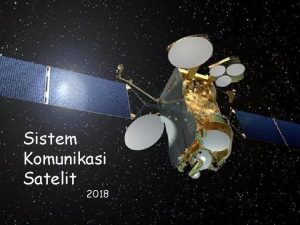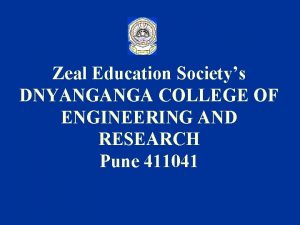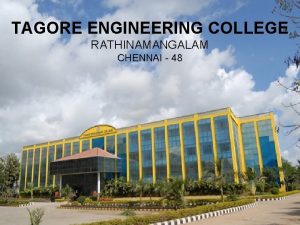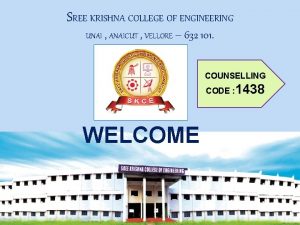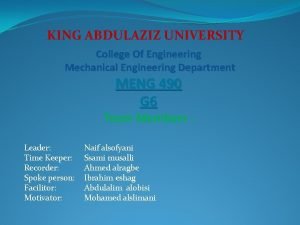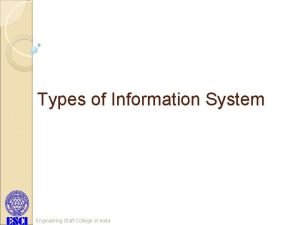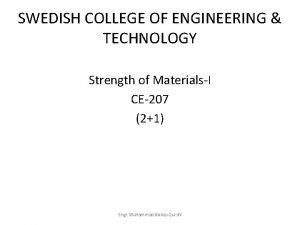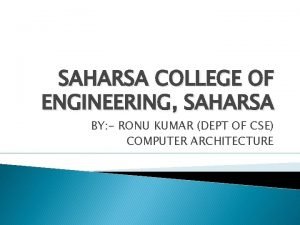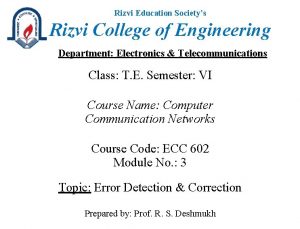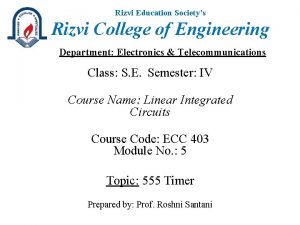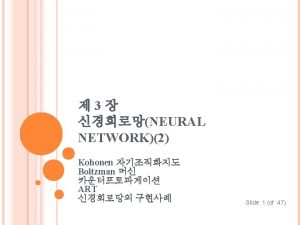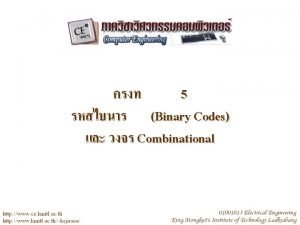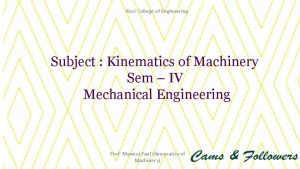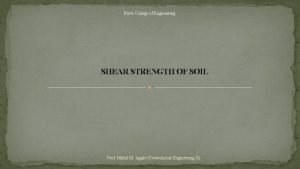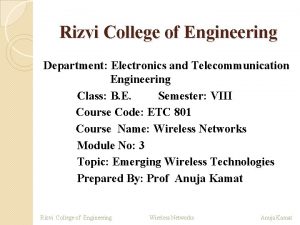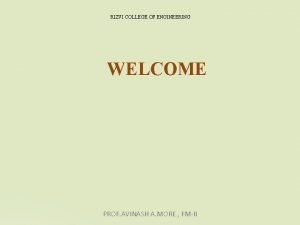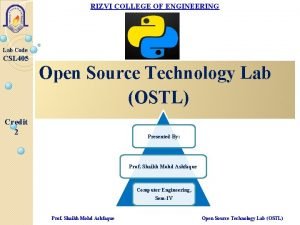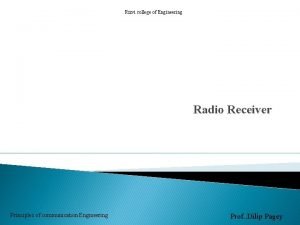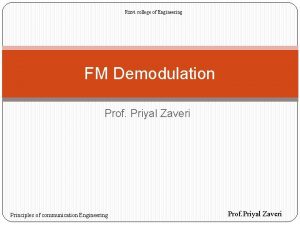EARTH SEGMENT Rizvi College of Engineering Earth segment






















- Slides: 22

EARTH SEGMENT

Rizvi College of Engineering Earth segment �Introduction �Receive-Only Home TV Systems �Outdoor Unit �Indoor Unit for Analog (FM) TV �Master Antenna TV System �Community Antenna TV System �Transmit-Receive Earth Stations Satellite Communication & Networks Prof. Nayna Dahatonde

Rizvi College of Engineering Satellite Segments A satellite communications system can be broadly classified into 2 segments: � Space Segment: includes the sat. And ground facilities (TT&CCommand) tracking, telemetry & �Earth Segment: consists of the transmit and receive earth stations. Satellite Communication & Networks Prof. Nayna Dahatonde

Rizvi College of Engineering Receive-Only Home TV systems �Planned broadcasting directly to home TV receivers (Direct Broadcast Satellite (DBS service). �Early, C-band (4 GHz), currently the Ku band: (12 GHz) �Large antennas (3 m diameter) were used with the C-band while smaller (<1 m diameter) are currently used with the Ku Band. Satellite Communication & Networks Prof. Nayna Dahatonde

Rizvi College of Engineering Satellite Communication & Networks Prof. Nayna Dahatonde

Rizvi College of Engineering Outdoor Unit • Consists of a receiving antenna feeding directly into a LNA/converter combination. • A parabolic reflector is generally used with the receiving horn mounted at the focus. Satellite Communication & Networks Prof. Nayna Dahatonde

Rizvi College of Engineering Outdoor Unit • 12. 2 -12. 7 GHz 500 MHz 32 TV/FM with 24 MHz each. • A polarizer may be switched from the indoor unit for polarization interleaving (LHC/RHC or H/V polarization) Satellite Communication & Networks Prof. Nayna Dahatonde

Rizvi College of Engineering Outdoor Unit • The horn feeds into the Low Noise Block (LNB) that contains an LNA+Converter. • LNB provides gain for the broadband 4/12 GHz signal then converts it to a lower frequency range so that a low -cost coaxial cable can be used as feeder to the indoor unit (950 -1450 MHz) Satellite Communication & Networks Prof. Nayna Dahatonde

Rizvi College of Engineering Indoor Unit for analog FM/TV • 12. 2 -12. 7 GHz 500 MHz 32 TV/FM with 24 MHz each. • The selected channel is down-converted to an IF frequency (70 MHz) where the most gain is achieved Satellite Communication & (FM system rather than VSB). Prof. Nayna Dahatonde Networks

Rizvi College of Engineering Master Antenna TV System �A master antenna TV (MATV) system is used to provide reception of DBS TV/FM channels to a small group of users �It consists of a single outdoor unit (antenna and LNA/C) feeding a number of indoor units Satellite Communication & Networks Prof. Nayna Dahatonde

Rizvi College of Engineering Master Antenna TV System Satellite Communication & Networks Prof. Nayna Dahatonde

Rizvi College of Engineering Community Antenna TV System Satellite Communication & Networks Prof. Nayna Dahatonde

Rizvi College of Engineering Community Antenna TV System �Instead of having a separate receiver for each user, all the carriers are demodulated in a common receiver-filter system �The channels are then combined into a standard multiplexed signal for transmission over cable to the subscribers Satellite Communication & Networks Prof. Nayna Dahatonde

Rizvi College of Engineering Transmit-Receive Earth Stations �In some situations, a transmit-only station is required �For example, �in relaying TV signals to the remote TV receive-only stations � Transmit-receive stations provide both functions �Transmit-Receive ES provide TX/RX functions that are required for telecommunications traffic generally including network TV. Satellite Communication & Networks Prof. Nayna Dahatonde

Rizvi College of Engineering Transmit-Receive Earth Stations Satellite Communication & Networks Prof. Nayna Dahatonde

Rizvi College of Engineering Satellite Communication & Networks Prof. Nayna Dahatonde

Rizvi College of Engineering Transmit-Receive Earth stations • Interconnection equipment is required for interconnecting the satellite station and terrestrial network. • MUX required for TX where a kind of reformatting is maintained. Here, Parallel IF stages are used. Satellite Communication & Networks Prof. Nayna Dahatonde

Rizvi College of Engineering Transmit-Receive Earth stations • Next, Modulators are used for TX function • QPSK/QAM for digital and FM for analog systems • The Upconvertor is implemented to upconvert the IF (70 MHZ) to RF (6, 14 GHz) Satellite Communication & Networks Prof. Nayna Dahatonde

Rizvi College of Engineering Transmit-Receive Earth stations • Next, carriers are combined and the resulting wideband signal is amplified and is fed to the antenna through the Diplexer, which allows simultaneous TX/RX operations • The ES antenna functions both TX and RX modes Satellite Communication & but at different frequencies (4/6, 12/14 GHz) Prof. Nayna Dahatonde Networks

Rizvi College of Engineering Traffic � Traffic can be broadly classified as �heavy route, �medium route, and �thin route. � In a thin-route circuit, a transponder channel (36 MHz) may be occupied by a number of single carriers, each associated with its own voice circuit. � This mode of operation is known as single carrier per channel (SCPC) � Antenna sizes range from 3. 6 m (11. 8 ft) for transportable stations up to 30 m (98. 4 ft) for a main terminal. Satellite Communication & Networks Prof. Nayna Dahatonde

Rizvi College of Engineering Medium route �A medium-route circuit also provides multiple access, either on the basis of �frequency-division multiple access (FDMA) or �time-division multiple access (TDMA) �Antenna sizes range from 30 m (89. 4 ft) for a main station to 10 m (32. 8 ft) for a remote station. Satellite Communication & Networks Prof. Nayna Dahatonde

Rizvi College of Engineering Heavy route �In a 6/4 -GHz heavy-route system, �each satellite channel (bandwidth 36 MHz) is capable of carrying over 960 one-way voice circuits simultaneously or �a single-color analog TV signal with associated audio �Thus the transponder channel for a heavy- route circuit carries one large-bandwidth signal which may be TV or multiplexed telephony. �The antenna diameter for a heavy-route circuit is at least 30 m (98. 4 ft). Satellite Communication & Networks Prof. Nayna Dahatonde
 Earth segment and space segment
Earth segment and space segment Segment by segment invasion
Segment by segment invasion Wake tech admissions
Wake tech admissions Early college high school at midland college
Early college high school at midland college Zeal dnyanganga college of engineering and research
Zeal dnyanganga college of engineering and research Thakur college of engineering and technology
Thakur college of engineering and technology Kate gleason college of engineering
Kate gleason college of engineering Ucf software engineering
Ucf software engineering Tagore engineering college rathinamangalam
Tagore engineering college rathinamangalam St anns college chirala
St anns college chirala Sree krishna college of engineering vellore
Sree krishna college of engineering vellore Khagaria engineering college
Khagaria engineering college College of engineering science and technology
College of engineering science and technology College of engineering, king abdulaziz university
College of engineering, king abdulaziz university Detritus food chain
Detritus food chain Uc ceas
Uc ceas Engineering staff college of india
Engineering staff college of india Swedish college of engineering and technology
Swedish college of engineering and technology Feng's classification in computer architecture
Feng's classification in computer architecture Computer based system engineering in software engineering
Computer based system engineering in software engineering Forward engineering in software engineering
Forward engineering in software engineering Principles of complex systems for systems engineering
Principles of complex systems for systems engineering Engineering elegant systems: theory of systems engineering
Engineering elegant systems: theory of systems engineering
